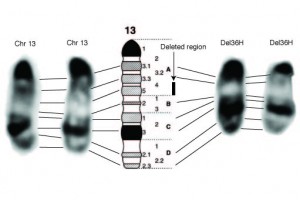 Mice are born with their eyes tightly shut, opening them for the first time only a few days later. So when a mouse was noticed that was smaller than normal and had been born with it’s eyes open, it drew attention. Abnormalities like this arise spontaneously in all animal facilities, but sometimes they are not one-offs, but inherited. It was not unexpected in this case, because the mother of this mouse was treated with X-rays to deliberately induce mutations, as part of a larger program of research aimed at producing animals that would be studied as models of human disease.
Mice are born with their eyes tightly shut, opening them for the first time only a few days later. So when a mouse was noticed that was smaller than normal and had been born with it’s eyes open, it drew attention. Abnormalities like this arise spontaneously in all animal facilities, but sometimes they are not one-offs, but inherited. It was not unexpected in this case, because the mother of this mouse was treated with X-rays to deliberately induce mutations, as part of a larger program of research aimed at producing animals that would be studied as models of human disease.
X-rays are the blunderbusses of genetic modification – almost no aim yet causing massive damage if they hit the target. Sometimes, they cause loss of whole chromosomes, or bits of chromosome are lost and the cellular DNA repair machinery sticks the pieces back together. In the rare cases where the damage is not lethal either to the germ cell or very early in development, congenital abnormalities are seen in some of the live-born.
It turned out that our small mouse had lost a chunk of one chromosome, resulting in many genes being present in only single copies, rather than the normal pairs.
There were two things we most wanted to know about our mouse – firstly, what other abnormalities did it have and secondly, how many (and which) genes had been deleted? These gaps in our knowledge were important because if we could fill them, it would help us to understand the pathological effects of the deletion and be in a better position to compare mouse and human. It turned out that our mouse had a constellation of symptoms – altered head shape, a mild tail kink together with eyes open at birth and smallness. Furthermore, some painstaking developmental studies showed that many mice with the partially deleted chromosome died between mid- and full-term of gestation.
We first found this mouse back when whole genome sequencing was very expensive and financially impractical, so we relied on a combination of other, older methods to find out which genes had been lost. The simplest method uses a chemical stain that marks chromosomes with a characteristic pattern of bands, visible down the microscope (it’s shown in the picture at the top of this post), allowing an estimate of the percentage of the genome lost – this gave surprisingly close agreement with another method, based on genetic mapping, suggesting that 200-500 genes were lost (we later worked out exactly how many – but that’s another story).
Despite the obvious differences, at the level of the genes, mice are a lot like humans – by chance, many of the genes deleted in our mouse have also been deleted in some humans. Furthermore, people with these partially deleted chromosomes have one of a number of complex congenital disorders or syndromes, depending upon which specific genes are lost. These deletions are fortunately rare, but some of the associated disorders are common e.g. hearing loss or heart defects. Paradoxically, rare genetic events like this can teach us something about the other more common causes of these conditions.
Our small mice may be useful in studying why the genes lost in people cause these specific abnormalities and even lead us to new therapies.
The work we did on this mouse was carried out at MRC Harwell and is described in detail burada.

1 Gerilink
[...] wrote previously about a small mouse (jargon name – Del(13)36H) that had lost some of it’s genes and [...]